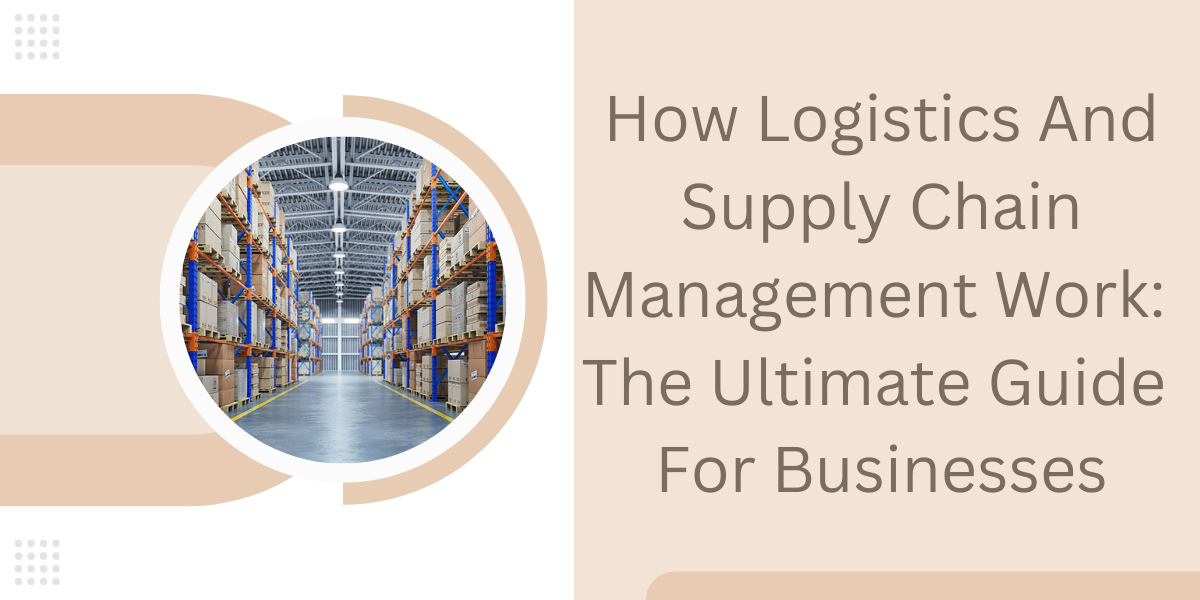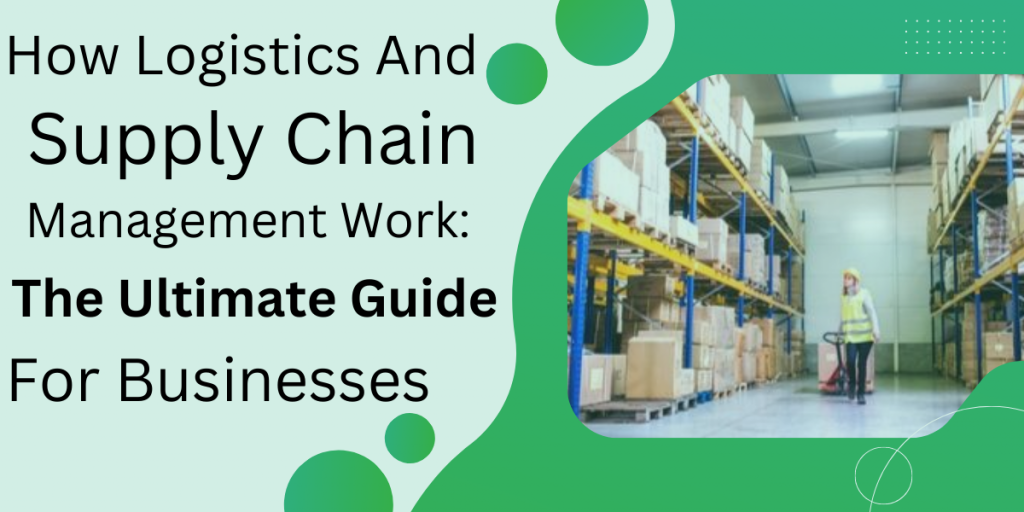How Logistics And Supply Chain Management Work: The Ultimate Guide For Businesses

Understanding how logistics and supply chain management work is critical for businesses. In this guide, we’ll explore what these terms mean and how they affect businesses. We’ll also provide some tips on how businesses can improve their logistics and supply chain management.
Logistics is the process of planning, implementing, and controlling the efficient, effective flow of goods, services, and related information from point of origin to point of consumption. Supply chain management is the coordination and management of these activities to optimize the movement of goods and materials throughout the supply chain.
What is logistics and supply chain management?
Logistics and supply chain management are two key components of any business. Logistics refers to the process of planning, organizing, and managing the transportation and storage of goods and materials. Supply chain management, on the other hand, encompasses the end-to-end process of acquiring raw materials, manufacturing products, and delivering them to customers.
An effective logistics and supply chain management system is vital for businesses in today’s global economy. It can help businesses save time and money, while also improving customer satisfaction.
There are many different aspects to consider when planning and managing a logistics or supply chain system. These include:
- Transportation: Getting goods and materials from point A to point B efficiently and cost-effectively is crucial. There are many different transportation options available, including airfreight, ocean freight, trucks, railroads, and even pipelines.
- Storage: Once goods have been transported to their destination, they need to be stored properly until they are needed. This involves choosing the right storage facility (e.g., warehouse, distribution center), as well as using appropriate inventory management techniques.
- Distribution: Once products have been manufactured, they need to be distributed to the appropriate retail outlets or customers. This involves planning routes and delivery schedules, as well as coordinating with retailers/customers.
- Customer service: Providing good customer service is essential for any business.
The benefits of efficient logistics and supply chain management
Logistics and supply chain management are essential for businesses of all sizes. By streamlining these operations, businesses can improve their bottom line and better compete in today’s global marketplace.
Efficient logistics and supply chain management can help businesses save money, time, and resources. In fact, a recent study by the Council of Supply Chain Management Professionals found that companies with efficient supply chains saw a 20 percent improvement in overall performance.
There are many ways to improve your company’s logistics and supply chain management. Here are a few tips:
- Improve communication throughout your organization. Open lines of communication between different departments will help ensure that everyone is on the same page and working towards the same goals.
- Use technology to your advantage. There are many software programs and online tools available to help streamline logistics and supply chain operations. Utilize these resources to make your process more efficient.
- Partner with a third-party logistics provider (3PL). A 3PL can take care of all your shipping needs, from warehousing to transportation. This will free up your staff to focus on other areas of the business.
- Implement Lean principles. Lean methodology can be applied to any business process to eliminate waste and improve efficiency.
- Continuously measure and monitor your progress. By tracking key metrics, you can identify areas that need improvement and make necessary changes to keep your operation running smoothly.
If You are Lookig For Best Logistics Company In Dubai then Click On The Blow Button.

The challenges of logistics and supply chain management
The challenges of logistics and supply chain management are many and varied. They include the need to effectively manage inventory, transportation, and other resources; to coordinate the activities of a large number of suppliers, manufacturers, distributors, and customers; and to respond quickly and efficiently to changes in demand.
In addition, logistics and supply chain management must take into account the political, economic, social, and cultural environment in which they operate. This includes understanding and responding to the needs of different stakeholders such as government agencies, local communities, NGOs, workers’ organizations, and so on.
Finally, logistics and supply chain management must be able to adapt to the ever-changing technology landscape. This includes being able to utilize new technologies as they become available and being able to effectively integrate them into existing systems.
How to overcome the challenges of logistics and supply chain management
The first step to overcoming the challenges of logistics and supply chain management is understanding what these terms actually mean. Logistics refers to the process of planning, implementing, and controlling the efficient movement and storage of goods, services, and people. Supply chain management, on the other hand, encompasses all the activities involved in getting a product or service from supplier to customer.
Now that we have a basic understanding of these concepts, let’s take a look at some of the most common challenges businesses face when it comes to logistics and supply chain management:
- Lack of visibility: One of the biggest challenges businesses face is lack of visibility into their supply chain. This can lead to inefficiencies and disruptions down the line.
- Complexity: Another challenge is complexity. As businesses grow, their supply chains often become more complex, making it difficult to manage them effectively.
- Fragmentation: Another common issue is fragmentation within the supply chain. This occurs when there are too many different parties involved in the process, which can lead to communication breakdowns and delays.
- Changing needs: The needs of customers can change rapidly, which can make it hard for businesses to keep up with demand. This is especially challenging for companies that have long lead times or inflexible production processes.
- Capacity constraints: Capacity constraints are another common issue faced by businesses with complex supply chains. This occurs when there isn’t enough capacity (e.g.,
Best practices for logistics and supply chain management
Logistics and supply chain management are critical components of any business. They ensure that goods and services are delivered to customers in a timely, efficient, and cost-effective manner.
There are a number of best practices that businesses should follow to ensure their logistics and supply chain management processes are effective:
- Establish clear objectives and KPIs: Without clear objectives, it can be difficult to measure the success of your logistics and supply chain management processes. Make sure you establish both short-term and long-term goals, as well as KPIs, so you can track progress and make necessary adjustments along the way.
- Develop a comprehensive strategy: Your logistics and supply chain strategy should be aligned with your overall business strategy. It should take into account your company’s strengths and weaknesses, as well as the opportunities and threats present in your industry and market.
- Build strong relationships with suppliers: Strong supplier relationships are essential for successful logistics and supply chain management. Make sure you partner with suppliers who share your commitment to quality and customer service. Also, develop robust communication channels so you can quickly resolve any issues that may arise.
- Invest in technology: Technology can help you optimize your logistics and supply chain processes. Automated systems can streamline order taking, inventory management, shipping, and more. Investing in the right technology solutions will save you time and money in the long run.
Tools for logistics and supply chain management
There are many different tools available for logistics and supply chain management. Some of the most popular include:
- Inventory management software: This type of software helps businesses keep track of their inventory levels, so they can order the right amount of product at the right time to meet customer demand.
- Transportation management software: This software helps businesses plan and execute efficient transportation routes for their products, so they can get them to customers on time and on budget.
- Warehouse management software: This software helps businesses optimize their warehouse operations, so they can store and ship products more efficiently.
- Supply chain planning software: This software helps businesses plan and coordinate their overall supply chain operations, so they can be sure that all of the links in the chain are working together smoothly.




